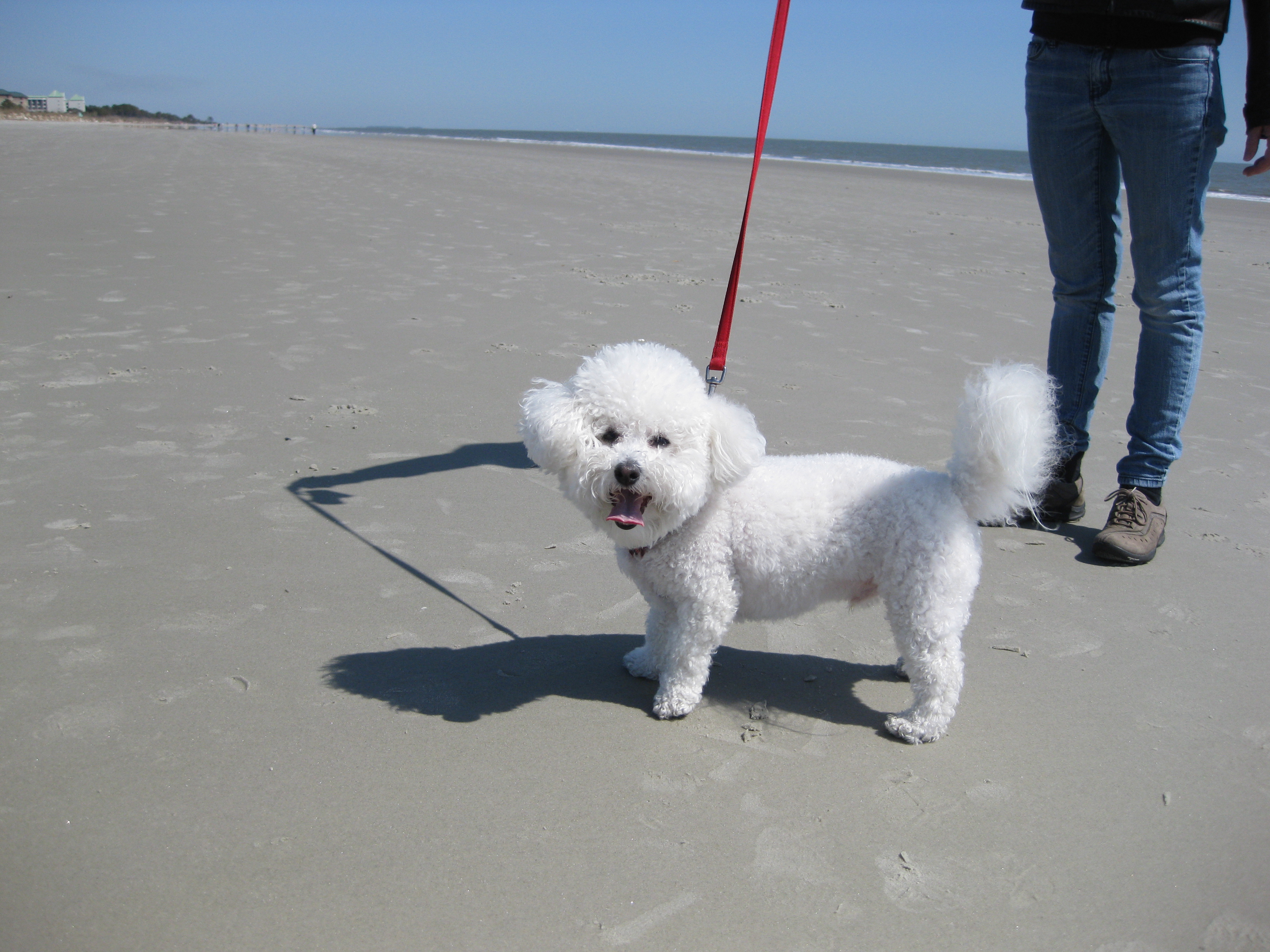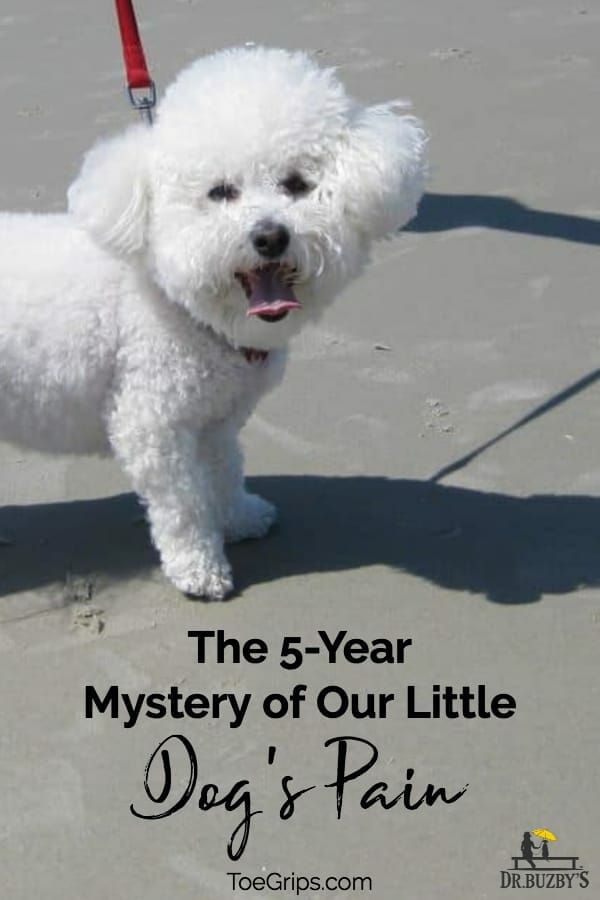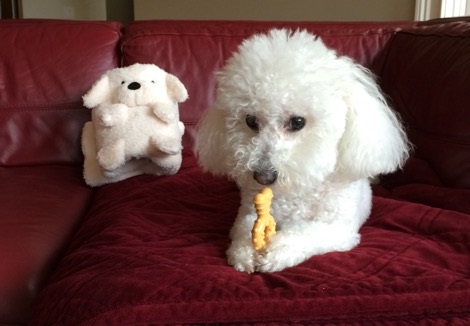
The Five-Year Mystery of Our Little Bichon Frise’s Pain
It was love at first sight seeing our clever little Bichon Frise doing tricks in return for treats and it was not long after that we adopted him.
~ Guest post by Steve and Cheryl Black
As a puppy, Conrad began having a few health issues
At a mere 4.8 lbs, he was more fluff than stuff, and with such a wonderful personality, he immediately won over our family’s affection. After taking him in for his first veterinary exam and shots, we became aware of a few health issues. Conrad was diagnosed with a mild luxating patella in the right back leg and curved spine; however, we realized both issues could be managed with proper care. As the months passed by, our little guy showed all the traits one would expect from the breed, a cheery personality, intelligence and attentiveness.
However, there were a few things that seemed a little off. While he enjoyed his treats and would eat his meals, he was really a picky sort of eater. Unlike our prior dogs (a Black Lab and a Golden Retriever), he was not a voracious eater and many times would leave food in the bowl. The other issues were that his stools were not all the well formed and he had occasional issues of vomiting, so we took him to our vet for a follow-up exam. Blood panels and tests were run and everything came up normal. All his organs were fine – which was for us, a big relief! At the time, we were living in a downtown Chicago and viruses were common, so that was the best guess diagnosis as the cause of his issues.
As Conrad approached six months of age, we noticed he could not jump up on the couch like other dogs and attributed that to his leg and back issues.
Still the appetite, stool, and vomiting issues persisted, and by now we’d moved and needed to find another vet. During the initial visit, we shared his history and she suggested that we change Conrad’s food from chicken to a grain-free duck food and put him on a mild probiotic for dogs. As we’d started to see some results, we switched to a stronger supplement (Proflora probiotic daily chew). And sure enough, we had success, his stool and appetite issues we’re gone. At this point, we noticed a marked change in his behavior toward his meals and grain-free treats. He became just as excited and voracious about his meals and treats as our prior dogs.
At about three years of age, Conrad started having some intense pain
It was so severe at times, he would pant and pace for hours, unable and unwilling to sit. He also had incidences of more severe bile vomiting, so we again took him in for evaluation. During the visit, the veterinarian observed that he had a back spasm. The hypothesis was that his spine and leg issues were contributing to the spasms, so we took the path of behavior modification and avoided situations and circumstances that would cause him to agitate his back (i.e. excessive jumping and running). Our vet also prescribed Tramadol to alleviate the pain he was experiencing, and this helped reduce the frequency and intensity of the spasms.
From “flare ups” to severe: Managing Conrad’s pain
As time progressed, we were able to mostly manage his pain, and yet we could not eliminate the “flare ups.” Two or three weeks, perhaps a month at best, and another incident was sure to follow. It’s important to understand, the pain Conrad was feeling at only five years old was severe and seeing a member of our family experience that pain was heart aching. There had to be another way of treating his condition, so we thought about alternative approaches.
Acupuncture came to mind and that is how we found Dr. Julie Buzby. After an initial assessment, we determined that Conrad would be more suitable for a chiropractic routine and we ran through a series of weekly sessions and saw some slight improvement, but nothing definitive. He was still taking frequent dosages of Tramadol. We just couldn’t get him off the drug. Being of a persistent nature, we asked what else might we try. Dr. Buzby mentioned some success with Adequan shots. So, for eight weeks we took him in for treatment, and it seemed to be helping, but not really curing the problem completely.
The “light-bulb” moment
During his last shot treatment, when discussing how Conrad was progressing, we arrived at a turning point. I casually mentioned to Dr. Buzby that Conrad did a “down dog” in front of his dog bowl at morning meal time before a pain episode took hold, but that nothing he did on his short morning walk could have agitated his back or legs.
From her body language and reaction, I could see whatever I said triggered a thought process and Dr. Julie quickly exclaimed, “Conrad’s pain may be coming from elsewhere, possibly his digestive tract!”
Putting the puzzle pieces together
How we thought? We’d already addressed that issue. To us, this hypothesis appeared to come out of left field. But, having spent some time over the last three months with Dr. Julie, we had complete trust in her judgment, capabilities, and most importantly, her sincerity and devotion to the dogs. She suggested we take Conrad into a specialist and have an ultrasound performed on his digestive tract.
The mystery of Conrad’s pain is solved
This was not an inexpensive alternative, but all things considered, we felt it was worth a try. So, we visited the specialist and he asked many detailed questions going all the way back to Conrad’s first days, from which he was able to rule out things like food allergies and such. He next performed an ultrasound and observed some slight indications that gallbladder “bile sludging” might be the cause of Conrad’s pain. This condition would explain the occasional vomiting as well as the pain episodes. So, with a reasonably high degree of confidence that this was the root cause of Conrad’s pain, he prescribed a daily bile thinner medication.
It’s now 3 months from that diagnosis and Conrad has been off Tramadol since taking the bile thinner and is now pain-free. He will be on the bile thinners for life with a normal life expectancy.
Lessons learned from solving Conrad’s mystery
In retrospect, Conrad’s situation was complex with various issues that were not easy to isolate. That said, there are a few key takeaways and lessons learned from this experience.
- Persistence and looking outside the box. If things aren’t right with your pet, check your premises. Something might have been overlooked along the way and do not be afraid to explore alternatives, conventional and non-conventional.
- Each step is a learning process. In Conrad’s case, we explored many hypotheses and tried a variety of approaches, which fortunately led us to Dr. Julie Buzby and ultimately to the right specialist and a cure.
- Trust, sincerity and competence. You need to have trust and confidence in your pet healthcare providers. If not, do some research to get better educated about symptoms, conditions, and potential diagnoses. If necessary, consider switching providers, getting a second opinion, or consulting a specialist.
Conrad’s case was especially challenging. Throughout all his exams and blood panels, the results were within the normal range and he had leg and back issues that could have been contributing factors, yet he still had a gallbladder issue that went undiagnosed and untreated for several years.
Steve and Cheryl Black




GREAT STORY SO GLAD THE MYSTERY WAS SOLVED. GREAT JOB DR. BUZBY AND FAMILY FOR YOUR PERSISTENCE IN FINDING THE CAUSE.